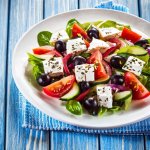Kritsinia are so tasty! They are not like the breadsticks we have in the US though, they are hard and crunchy but great for snacking. Here's how to make them
Place the yeast, sugar, 1/4 cup of the flour, and water into a medium bowl and mix together using a whisk or wooden spoon. This should make a thin batter. Leave it uncovered on the counter in a warm place and leave alone until it looks foamy. If you want the bread to have a sourdough taste, you can let it stand for up to 2 hours.
Add the rest of the flour, and salt and stir it vigorously using a wooden spoon. Stir in the yeast mixture. When the dough starts to come together, add some flour to your work surface and your hands and pour the dough onto it. Knead the dough for 5 minutes, continuing to add small amounts of all-purpose flour until the dough is smooth and no longer sticky.
Spray the bowl with nonstick cooking spray or coat it with oil. Place the dough in the center of the pan and massage the top of the dough with oil. Cover the pan with plastic wrap or a large, clean towel and set aside in a warm place until the dough doubles in size. This should take up to 2 1/2 hours, but it all depends on how warm the environment is.
Punch down the dough after it rises and lightly flour the work surface once again. Knead for about 2 minutes, or until the dough is elastic. Spray a baking sheet with nonstick cooking spray. Form the dough into a round loaf shape and place on the baking sheet. Massage the top of the loaf with more olive oil. Set the baking sheet aside until the loaf doubles in size.
When the loaf is ready to bake, preheat the oven to 400 degrees Fahrenheit. Brush the top of the loaf with water and then place the baking sheet in the center of the oven and bake for 30 minutes. Remove the loaf from the oven and brush it again with water. Place the loaf back in the oven and cook for an additional 15 minutes. You’ll know the loaf is done because when you knock on it with your knuckles, it will sound hollow. Remove the loaf from the oven and let it cool on the counter for at least 5 minutes before cutting into it.
I found this recipe from https://www.greekboston.com/food/breadsticks-recipe/
Enjoy and let me know if you like them!
- 1 package active dry yeast
- 1 teaspoon sugar
- 3 cups all-purpose flour plus more if needed
- 1 cup warm water
- 1 1/2 teaspoons salt
- 1/8 cup Greek olive oil, plus extra for the baking sheets
- 1 large egg
- 1 tablespoon water
- 1/2 cup sesame seeds
- Extra all-purpose flour for your hands and the work surface
Place the yeast, sugar, 1/4 cup of the flour, and water into a medium bowl and mix together using a whisk or wooden spoon. This should make a thin batter. Leave it uncovered on the counter in a warm place and leave alone until it looks foamy. If you want the bread to have a sourdough taste, you can let it stand for up to 2 hours.
Add the rest of the flour, and salt and stir it vigorously using a wooden spoon. Stir in the yeast mixture. When the dough starts to come together, add some flour to your work surface and your hands and pour the dough onto it. Knead the dough for 5 minutes, continuing to add small amounts of all-purpose flour until the dough is smooth and no longer sticky.
Spray the bowl with nonstick cooking spray or coat it with oil. Place the dough in the center of the pan and massage the top of the dough with oil. Cover the pan with plastic wrap or a large, clean towel and set aside in a warm place until the dough doubles in size. This should take up to 2 1/2 hours, but it all depends on how warm the environment is.
Punch down the dough after it rises and lightly flour the work surface once again. Knead for about 2 minutes, or until the dough is elastic. Spray a baking sheet with nonstick cooking spray. Form the dough into a round loaf shape and place on the baking sheet. Massage the top of the loaf with more olive oil. Set the baking sheet aside until the loaf doubles in size.
When the loaf is ready to bake, preheat the oven to 400 degrees Fahrenheit. Brush the top of the loaf with water and then place the baking sheet in the center of the oven and bake for 30 minutes. Remove the loaf from the oven and brush it again with water. Place the loaf back in the oven and cook for an additional 15 minutes. You’ll know the loaf is done because when you knock on it with your knuckles, it will sound hollow. Remove the loaf from the oven and let it cool on the counter for at least 5 minutes before cutting into it.
I found this recipe from https://www.greekboston.com/food/breadsticks-recipe/
Enjoy and let me know if you like them!
Last edited by a moderator:



